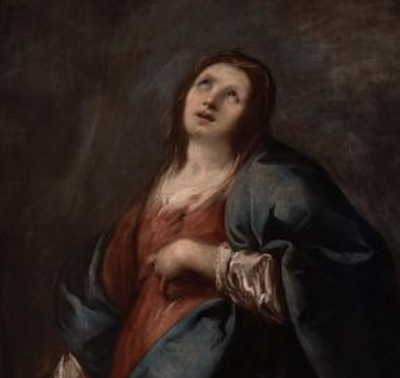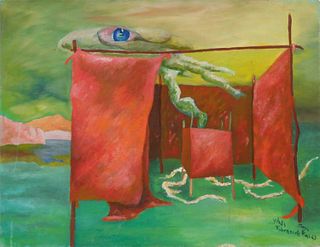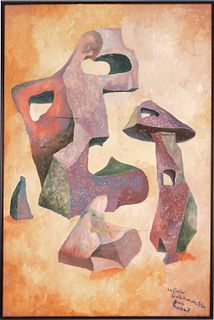Italian school; XVII century "St Geronimo". Oil on canvas. Relined. Measurements: 116 x 86 cm.
Lot 105
About Seller
Setdart Auction House
Carrer Aragó 346
Barcelona
Spain
Setdart Subastas was born in 2004 and is currently the first online art auction in Spain with solidity, prestige and reliability guaranteed by our more than 60,000 users. Setdart has a young, dynamic and enterprising team ready to successfully manage the purchase and sale of art works through custom...Read more
Estimate:
EUR€5,000 - EUR€6,000
$5,376.34 - $6,451.61
Absentee vs Live bid
Two ways to bid:
- Leave a max absentee bid and the platform will bid on your behalf up to your maximum bid during the live auction.
- Bid live during the auction and your bids will be submitted real-time to the auctioneer.
Bid Increments
| Price | Bid Increment |
|---|---|
| EUR€0 | EUR€10 |
| EUR€200 | EUR€25 |
| EUR€500 | EUR€50 |
| EUR€1,000 | EUR€100 |
| EUR€3,000 | EUR€200 |
| EUR€5,000 | EUR€500 |
| EUR€10,000 | EUR€1,000 |
| EUR€20,000 | EUR€2,000 |
| EUR€50,000 | EUR€5,000 |
About Auction
By Setdart Auction House
May 31, 2021
Set Reminder
2021-05-31 08:30:00
2021-05-31 08:30:00
America/New_York
Bidsquare
Bidsquare : OLD MASTERS - Day 1
https://www.bidsquare.com/auctions/setdart-auction-house/old-masters---day-1-6998
Setdart Auction House sofia@setdart.com
Setdart Auction House sofia@setdart.com
- Lot Description
Italian school; XVII century "St Geronimo". Oil on canvas. Relined. Measurements: 116 x 86 cm. Measures: 64 x 84 cm; 93 x 111 cm (frame). The present canvas presents a typical iconography of the 17th century, showing Saint Jerome. He achieved great popularity during the Counter-Reformation, due to his repentance and contemplative life, values useful to move the faithful. In this composition the saint is inscribed in a dark interior, barely dressed in a red cloak, with his head bent down contemplating a skull, which he holds in his hands. In front of him can be seen a table on which are arranged a pen and several bundles of papers. Due to the sobriety of the work, which centralizes its composition in the presence of the Saint, the colors, the light and dark and also the detail of the skull in his hands, it is worth mentioning that this piece has a great similarity with some of the works by José de Ribera. An example of this is the one that belongs to the Thyssen Bornemisza collection, made in 1634, or the one in the Prado Museum in Madrid, where the figure of St. Jerome is younger, as in this particular case. Saint Jerome is one of the four great Doctors of the Latin Church, born near Aquileia (Italy) in 347. Trained in Rome, he was an accomplished rhetorician, as well as a polyglot. Baptized at the age of nineteen, between 375 and 378 he retired to the Syrian desert to lead an anchorite's life. He returned to Rome in 382 and became a collaborator of Pope Damasus. In the second half of the 16th century a new iconography emerged in which the saint listens to the trumpet of the Apocalypse, an iconography widely used by the Counter-Reformation Church. The famous saint is usually depicted inside a cave or in the middle of the desert, and is usually, although not always, accompanied by his characteristic attributes: the stone, symbolizing the rigor of penance, with which he beats his chest; the skull, symbolizing death, and the red mantle that reflects the tradition that made him a cardinal. The accumulation of books and parchments next to the saint alludes to the saint's translation of the Bible into Latin, which was considered the only official translation since the Council of Trent. Finally, the theme of St. Jerome hearing the trumpet of the Last Judgment will become fashionable in Counter-Reformation Europe, and will gradually impose itself, displacing the previous interpretations of the saint as a sage or as a penitent.
- Shipping Info
-
In-house shipping available. Please inquire at admin@setdart.com.
-
- Buyer's Premium



 EUR
EUR CAD
CAD AUD
AUD GBP
GBP MXN
MXN HKD
HKD CNY
CNY MYR
MYR SEK
SEK SGD
SGD CHF
CHF THB
THB


















